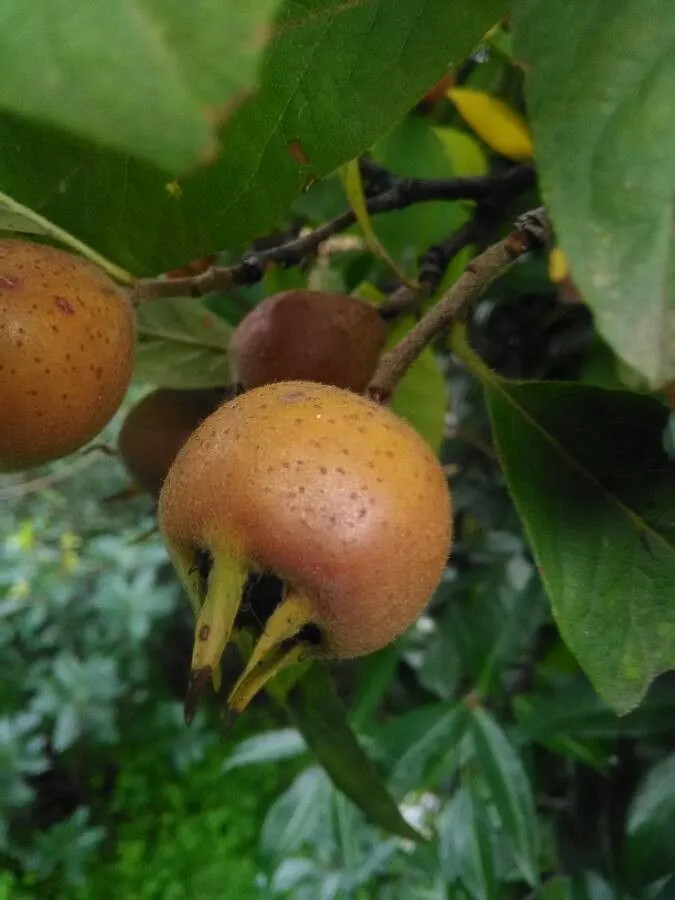
Author: L.
Bibliography: L. (1753). In: Sp. Pl. 478.
Year: Unknown
Status: accepted
Rank: species
Genus: Mespilus
Vegetable: Unknown
Observations: Unknown
The Medlar, scientifically known as Mespilus germanica, is a deciduous tree belonging to the Rosaceae family. This small tree or large shrub is notable for its unique, somewhat exotic fruits and charming white to pinkish flowers that typically bloom in late spring.
Characterized by its twisted and gnarled trunk, the Medlar can grow up to 6 meters in height and equally as wide. The leaves are simple, lance-shaped, and display a brilliant green that transitions to vibrant yellows and reds in the autumn, providing seasonal aesthetics to any garden or landscape.
The Medlar fruit is distinctive and intriguing. Resembling a large, open-ended rosehip, it is initially hard and green, maturing to a brownish color. The fruit must undergo a process known as ‘bletting’ to become edible, which involves allowing it to soften and sweeten by either leaving it on the tree into winter or storing it until it becomes almost overripe. When bletted, the flesh takes on a soft, custard-like consistency with a unique flavor profile combining hints of applesauce, dates, and cinnamon.
Historically, the Medlar has been cultivated since Roman times for its fruit, which was highly prized throughout the Middle Ages in Europe. Despite its relative obscurity today, it still holds a niche appeal among gardeners and fruit enthusiasts who appreciate its storied history and unique taste.
While not commonly found in modern commercial orchards, the Medlar can be a delightful addition to home gardens, particularly within temperate climates. Its resilience and low maintenance, along with its unusual fruit, make it a fascinating plant to grow and enjoy both for its historical significance and its intriguing culinary possibilities.
In summary, the Medlar (Mespilus germanica) is a captivating plant that offers historical richness, seasonal beauty, and unique fruit. Its inclusion in gardens brings a touch of the past and an opportunity to explore rare flavors, making it a special, albeit uncommon, treasure among fruit-bearing trees.
Deu: deutsche mispel, echte mispel, mispel, mispelbaum
Eng: medlar, common medlar
Fra: néflier, néflier commun, néflier d’allemagne
Nld: mispel
Swe: mispel
Ces: mišpula oby, mišpule obecná
Por: nespereira, nespereira-da-europa
Spa: níspero común, níspero europeo
Cym: afal tindwll, dindoll, merysbren, merysbren afal agored, merysbrennau, meryswydden, tinagored, tindoll
En: Medlar, Gnespolâr, Common medlar
Sq: Mushmolla
Ar: زعرور جرماني
Hy: Զկեռնի գերմանական
Az: Alman əzgili
Eu: Mizpira
Be: Мушмула германская
Bg: Обикновена мушмула
Ca: Nespler, Nesprer
Zh: 欧楂, 歐楂
Hr: Mušmula
Cs: Mišpule obecná, Mišpula oby
Da: Mispel
Nl: Mispel
Eo: Mespilujo
Et: Harilik astelpihlakas
Fi: Mispeli
Fr: Néflier, Néflier commun, Néflier d’Allemagne
Gl: Nespereira europea
Ka: Ზღმარტლი
De: Mispel, Mispelbaum, Deutsche Mispel, Echte Mispel
El: Μεσπιλέα η γερμανική
Ga: Meispeal
It: Nespolo comune, Nespolo di Germania
Ko: 양모과
Lv: Mespils
Li: Mispel
Lt: Šliandra
Lb: Aaspel
Mk: Мушмула
Gv: Meidil
Ne: लौकाट (फल)
No: Ekte mispel
Oc: Mesplièr
Os: Мугæ
Fa: ازگیل
Pl: Nieszpułka zwyczajna
Pt: Nespereira, Nespereira-da-europa
Ro: Moşmon
Ru: Мушмула германская
Sc: Nespulo
Sr: Обична мушмула
Sk: Mišpuľa obyčajná
Es: Níspero común, Níspero europeo, Nešplja, Níspero, Niespolero, Nispero negro
Sv: Mispel
Zh-tw: 歐楂
Ta: மகிலா மரம்
Zh-hant: 歐楂
Tr: Muşmula
Uk: Чишкун звичайний
Uz: Mushmula
Wa: Mesplî
Cy: Merysbren, Afal Tindwll, Dindoll, Merysbren Afal Agored, Merysbrennau, Meryswydden, Tinagored, Tindoll
Taken Dec 10, 2021 by gecko8 (cc-by-sa)
Taken Oct 21, 2020 by Arnaud Lupia (cc-by-sa)
Taken Sep 27, 2020 by Borgio Bruno (cc-by-sa)
Taken Nov 18, 2018 by shardana (cc-by-sa)
Taken Jan 26, 2022 by Jardin Botanique (cc-by-sa)
Taken Aug 4, 2020 by Winfried Bühler (cc-by-sa)
Taken May 19, 2016 by Jan Willem Lignac (cc-by-sa)
Taken May 19, 2016 by Jan Willem Lignac (cc-by-sa)
Taken Jan 30, 2022 by Шамхалов Магомед (cc-by-sa)
Taken Jan 26, 2022 by Jardin Botanique (cc-by-sa)
Taken Jul 6, 2022 by Iemima Moisiuc (cc-by-sa)
Taken May 9, 2021 by t. bulent (cc-by-sa)
Taken Aug 23, 2022 by Tom Wright (cc-by-sa)
Taken Jan 10, 2020 by benj delem (cc-by-sa)
Taken Sep 26, 2020 by matteo b (cc-by-sa)
Taken Sep 8, 2019 by Погорелов Денис (cc-by-sa)
Taken Aug 10, 2018 by Rozowski Dieter (cc-by-sa)
Taken Sep 6, 2020 by Tobi Amos (cc-by-sa)
Taken Nov 24, 2015 by EOL − danielabejarano (cc-by-nc)
Taken Oct 21, 2020 by Arnaud Lupia (cc-by-sa)
Taken Aug 21, 2020 by Nelly Garnier (cc-by-sa)
Taken Aug 20, 2014 by Tela Botanica − Red Marie (cc-by-sa)
Taken Aug 21, 2014 by Tela Botanica − Ricalens Eric (cc-by-sa)
Taken May 13, 2019 by Wilhelm Rogmann (cc-by-sa)
Taken Aug 21, 2014 by Tela Botanica − Ricalens Eric (cc-by-sa)
Taken Oct 31, 2016 by Dieter Albrecht (cc-by-sa)
Taken Apr 27, 2021 by Denis Alkan (cc-by-sa)
Taken May 10, 2022 by Cener (cc-by-sa)
Taken Sep 27, 2020 by Marina (cc-by-sa)
Taken May 8, 2020 by Maxime PAPIN (cc-by-sa)
Family: Myrtaceae Author: (F.Muell.) K.D.Hill & L.A.S.Johnson Bibliography: Telopea 6: 402 (1995) Year: 1995 Status:…
Family: Rubiaceae Author: Pierre ex A.Froehner Bibliography: Notizbl. Bot. Gart. Berlin-Dahlem 1: 237 (1897) Year:…
Family: Sapindaceae Author: Koidz. Bibliography: J. Coll. Sci. Imp. Univ. Tokyo 32(1): 38 (1911) Year:…
Family: Asteraceae Author: A.Gray Bibliography: Pacif. Railr. Rep.: 107 (1857) Year: 1857 Status: accepted Rank:…
Family: Fabaceae Author: Medik. Bibliography: Vorles. Churpfälz. Phys.-Ökon. Ges. 2: 398 (1787) Year: 1787 Status:…
Family: Aspleniaceae Author: (Cav.) Alston Bibliography: Bull. Misc. Inform. Kew 1932: 309 (1932) Year: 1932…